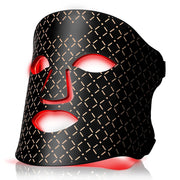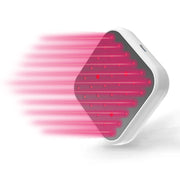Red light therapy and infrared saunas are two of the most popular technologies in health and wellness right now. You’ll find them at gyms and spas, and in private homes. Celebrities, medical professionals, and fitness gurus alike tout the benefits of these naturally derived therapies.
All this attention begs the question: Red Light Therapy Vs Infrared Sauna: Which one is better? And—do you even have to choose?
Actually, you don’t. When comparing infrared sauna with red light therapy, it’s clear that both provide a number of health benefits, albeit in very different ways. Saunas are one of the oldest therapies around, and they rely on heat. Red light therapy is a cutting edge technology that relies on light. Let’s take a closer look at both to see how they work—and how they can work together.
Sauna: An Ancient Therapy that Still Works
Heat-based therapies have been around for millennia. From Turkish baths, to Mayan sweat houses, to Japanese onsen, the ritual of getting hot and sweaty for therapeutic purposes has a sacred place in many cultures.
For the Finns, it started with hot earth pits that evolved into rooms heated by smokey wood stoves—the prototype of the Finnish sauna, which means “bathhouse” in Finnish.
A hallmark of Finnish culture, saunas gained worldwide popularity in the 20th century. Modern saunas feature heated wooden walls and a compartment of stones warmed by an electric heater. Together, these elements generate an envelope of dry heat with temperatures oscillating between 150 and 185º F. The sauna-goer lingers in this hot little space, sweats profusely, and emerges feeling refreshed and all a-glow.
Saunas: Sweat Without Exercise
 The relaxing and often social ritual of taking a sauna yields health benefits that modern science has only begun to comprehend.
The relaxing and often social ritual of taking a sauna yields health benefits that modern science has only begun to comprehend.
One interesting discovery in sauna research involves “heat shock proteins”, which are specialized stress proteins that protect and repair cells and bolster the immune system. Normally, these proteins activate when body temperature spikes, such as during exercise. However, recent studies indicate that passive heat—like that experienced in a sauna—can produce similar effects. This is great news for people who, for whatever reason, can’t tolerate the physical stress of exercise but desire its physiological effects.
Taking a sauna post-exercise has been shown to have benefits as well. In one well-known study, six male distance runners took a sauna after each training session, for three weeks. After the three weeks, researchers noted “a worthwhile enhancement of endurance running performance, probably by increasing blood volume.”
There’s also a fair bit of evidence to suggest that sweating helps rid the body of toxins—which is surprising considering that this function is primarily taken care of by the liver and kidneys. One study found the amounts of toxic elements such as cadmium, lead, and aluminum excreted in sweat were greater than the amounts excreted in urine. This is promising news when you consider the growing body of research warning about high levels of harmful substances and heavy metals that leach into our bodies from the environment.
Infrared Saunas: Same Heat, Different Source
 Ever since astronomer Sir William Herschel discovered infrared radiation (IR) in 1800, scientists have been fascinated by its properties. Extending from the red edge of the visible spectrum at 700 nanometers to 1 millimeter, IR is emitted by all objects in the universe to some degree.
Ever since astronomer Sir William Herschel discovered infrared radiation (IR) in 1800, scientists have been fascinated by its properties. Extending from the red edge of the visible spectrum at 700 nanometers to 1 millimeter, IR is emitted by all objects in the universe to some degree.
Infrared heat works something like this: Imagine a sunny day in the middle of winter. The air around you is cold, but the sun warms your face. That’s the sun’s infrared rays at work, warming your face as they penetrate your skin. You feel the warmth despite the cold ambient temperature of the air around you.
In 1965, a Japanese doctor put this science to work and patented the first infrared light sauna. Unlike traditional saunas, where an electric heater or wood stove heats the air and the objects in it through convection, infrared saunas use radiant heat coming from an IR heat lamp, which directs warmth toward the body as well as other objects in the room.
What this means is that the air inside an infrared sauna doesn’t need to be really hot in order for you to sweat. In fact, infrared saunas maintain an ambient heat of 110 degrees F to 130 degrees F, which some people find more comfortable than the range of traditional saunas. Infrared saunas still make you sweat—a lot—thereby generating all the benefits of a traditional sauna, but with less overall stress on the body.
In Infrared Saunas, Wavelength Matters
Most infrared sauna models rely on light waves in the far infrared part of the spectrum, known as far infrared light (FIR). With a range of 3000 nm to 0.1 mm, FIR light is the only kind of infrared light capable of raising your core temperature in a way that simulates the heat stress of traditional saunas and exercise. FIR saunas feature metallic, ceramic, or black carbon heating elements (the last being the safest and most modern option), and they are often built of wood, like their traditional counterparts.
The research on FIR sauna therapy is nascent but promising. One paper summarizes studies showing that time spent in FIR saunas improved quality of life in patients with Type II diabetes; improved cardiac and vascular function in patients with chronic heart failure; and eased pain, stiffness, and fatigue in patients with conditions like rheumatoid arthritis.
All things considered, FIR sauna therapy is one way for patients with inhibitory health problems to feel the benefits of exercise without actually doing it—and without having to withstand the intense temperatures of a super hot Finnish sauna.
Near Infrared Saunas
A few infrared light saunas on the market use near-infrared light (NIR), which starts at 700 and tops out around 1400 nm. Near infrared light does not produce heat, so it won’t light your internal fire the way FIR does. The warmth of an NIR sauna comes from the incandescent light bulbs that power its heat lamps—and those bulbs get awfully hot to the touch.
Often, NIR sauna manufacturers say they use incandescent light bulbs in order to harness a broader spectrum that includes therapeutically beneficial light bands—namely, red light wavelengths of 630 nm and 660 nm, and near-infrared wavelengths of 810 nm, 830 nm, and 850 nm. These bands of light have been scientifically proven to yield benefits for humans—and they happen to be the same ones harnessed in red light therapy. But we’ll get into that a little later, and look at why NIR saunas can’t effectively provide red light therapy from incandescent light bulbs.
Summary of Infrared Saunas
They heat the body in order to activate physical benefits, in the same way traditional saunas do. These physical benefits include:
 Activating heat shock proteins, shown to bolster the immune system and repair cells;
Activating heat shock proteins, shown to bolster the immune system and repair cells;
 Increasing blood flow to enhance recovery and endurance, post-exercise;
Increasing blood flow to enhance recovery and endurance, post-exercise;
 Sweating out toxins. Note that some manufacturers falsely claim that infrared saunas make you generate sweat that contains up to 20% more toxins than that which is generated by traditional saunas. There is zero evidence to back this up.
Sweating out toxins. Note that some manufacturers falsely claim that infrared saunas make you generate sweat that contains up to 20% more toxins than that which is generated by traditional saunas. There is zero evidence to back this up.
 Infrared saunas are less hot than traditional saunas—and thus more comfortable for some people.
Infrared saunas are less hot than traditional saunas—and thus more comfortable for some people.
 Most infrared saunas employ far infrared light waves, which are more effective at generating heat.
Most infrared saunas employ far infrared light waves, which are more effective at generating heat.
 Some infrared saunas use near infrared light waves, which don’t generate heat; rather, the warmth in the sauna space is due to heat emitted from incandescent light bulbs.
Some infrared saunas use near infrared light waves, which don’t generate heat; rather, the warmth in the sauna space is due to heat emitted from incandescent light bulbs.









